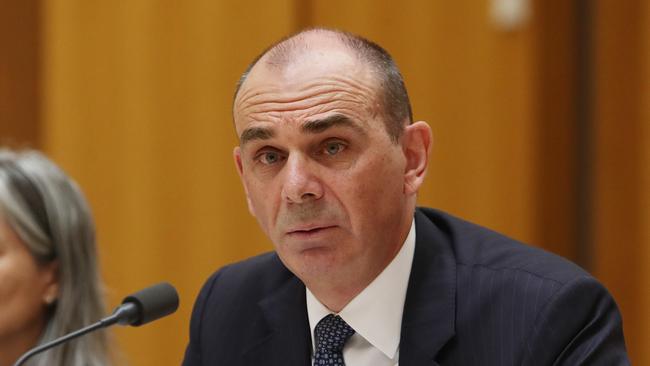APRA mortgage move set to ease home lending squeeze
Borrowers are set to face a lower interest rate hurdle before they can get a home loan.

The banking regulator has buckled to pressure to loosen regulations on responsible lending laws, proposing to reduce the minimum interest rate hurdle borrowers need to clear before they can get approval for a loan.
The Australian Prudential Regulation Authority has flagged lowering the minimum interest rate serviceability buffer from 7 per cent to a level determined by banks and other lenders.
The buffer has been in place to ensure that any mortgage borrower is able to meet repayments on higher than current interest rates. Banks have typically added a further 25 basis points to the 7 per cent threshold taking it to 7.25 per cent.
The other measure APRA has previously urged banks to use is a 2 per cent buffer over the loan’s interest rate, which banks raised to 2.25 per cent. The regulator wants this buffer to increase to 2.5 per cent.
With official interest rates at record lows, and with the Reserve Bank expected to cut rates even lower, parts of the banking sector have called for the buffer to be reviewed.
Lowering the hurdle would also provide support for the struggling housing market, following a 10 per cent slide in national house prices with steeper falls in Melbourne and Sydney.
Bank shares surged in early trade on the news, with ANZ up 5 per cent and the Commonwealth Bank up 3.1 per cent, while the Australian dollar jumped 22 points to an intraday high of US69.29c.
The move may be a positive “double-whammy” for banks, in that it helps credit growth and reduces pressure on margins by lessening the need for rate cuts.
ANZ’s head of Australia economics David Plank said APRA’s announcement represented “a material easing” in the credit constraint facing households.
“In its recent update to the market, ANZ estimated that household borrowing capacity has been reduced by about 30 per cent because of the various steps taken by the regulator over a number of years and last year’s focus on the use of HEM (Household Expenditure Method).
“ANZ estimates that the serving rate floor was responsible for almost a third of this reduction,” he said in a note to clients.
“The use of a floor won’t disappear, but it seems reasonable to think it will come down some way from the current 7.25 per cent used by the major banks. Certainly to something with a 6 handle on it. This is an effective easing in policy settings, in our view.”
The Commonwealth Bank said it welcomed the opportunity to consult with APRA over the proposed changes, while the NAB said the move should increase an individual’s borrowing capacity and would “enhance the effectiveness” of any future RBA rate cuts.
APRA has set a four-week consultation period on the proposals, but they are expected to be confirmed.
The proposed ditching of the buffer is the latest move by APRA to remove restrictions on the banking sector, after dumping its 10 per cent growth cap on investor lending and casting aside its 30 per cent limit on interest-only lending.

APRA chairman Wayne Byres said much had changed since 2014 when the regulator launched its intervention in the housing market, amid loose lending standards in the banking sector.
“APRA introduced this guidance as part of a suite of measures designed to reinforce sound residential lending standards at a time of heightened risk,” Mr Byres said.
“Although many of those risk factors remain – high house prices, low interest rates, high household debt, and subdued income growth – two more recent developments have led us to review the appropriateness of the interest rate floor,” he said.
“With interest rates at record lows, and likely to remain at historically low levels for some time, the gap between the 7 per cent floor and actual rates paid has become quite wide in some cases – possibly unnecessarily so.
“In addition, the introduction of differential pricing in recent years – with a substantial gap emerging between interest rates for owner-occupiers with principal-and-interest loans on the one hand, and investors with interest-only loans on the other – has meant that the merits of a single floor rate across all products have been substantially reduced.
“The changes, while likely to increase the maximum borrowing capacity for a given borrower, are not intended to signify any lessening in the importance that APRA places on the maintenance of sound lending standards.
“Rather, it is simply recognition that the current interest rate environment does not warrant a uniform mandated interest rate floor of 7 per cent across all products.”
Property chiefs had been pushing for a shift in the APRA lending buffers
Today, the Property Council of Australia welcomed the APRA move as “timely”, and that it recognised “the changed circumstances in the current interest rate environment for lenders and the residential housing market”.
“It makes sense to revisit some of the measures originally put in place at the peak of the housing market. Different markets need different settings,” said council CEO Ken Morrison.
ANZ Bank chief executive Shayne Elliott had also expressed support for a rethink of the levels.
Earlier this month, Mr Elliott said the buffers had become less useful as official interest rates hovered at record lows and further cuts loomed.
Banks have applied the benchmark mortgage rate plus 2.25 per cent, or 7.25 per cent, whichever is higher to assess serviceability of a loan.
“The lower interest rates get the less likely it is that rates are going to get to 7.25 per cent any time soon,” Mr Elliott said. “At some point you need to rethink it … commonsense says it should be relative to where the interest rate cycle is.”
The APRA moves come after banking stocks surged yesterday in the wake of the nation’s rejection of the Labor party at the federal election.
The opposition had proposed tougher standards on the banking sector and a suite of tax reforms that critics said would have added further downward pressure on house prices and property investment.




To join the conversation, please log in. Don't have an account? Register
Join the conversation, you are commenting as Logout